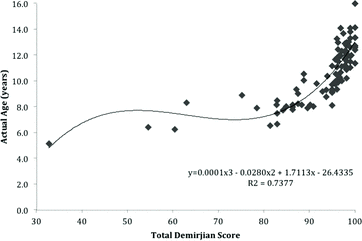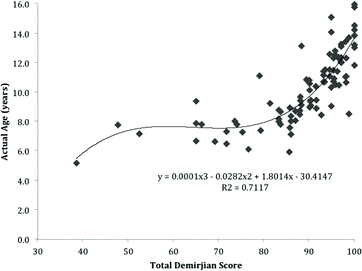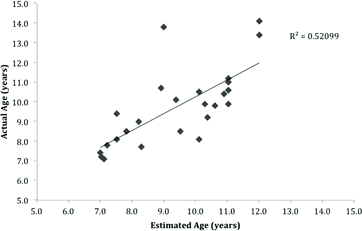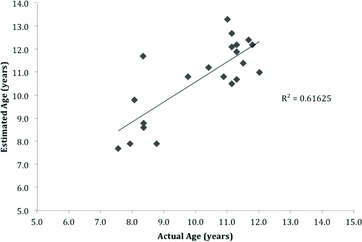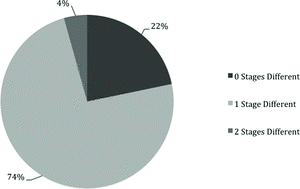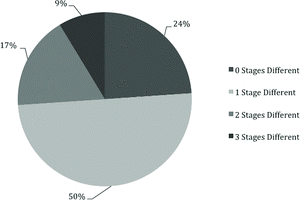Abstract
Dentition is commonly used to determine age because disease and nutritional factors minimally impact dental maturation. This study evaluated the use of Demirjian’s method of estimating age for a population from Sudbury, Ontario, Canada. A sample of 245 panoramic radiographs, taken from male and female children aged 5–16 years of varying ancestries, was collected from two local dental practices. Eight radiographs were excluded due to distortion or congenitally missing teeth. The results indicate a general over-estimation of age across all ages, with the only significant under-estimation of age evident in 15 and 16 year-olds. Inter- and intra-observer agreement has been documented for both boys and girls. This study yielded a Sudbury-specific set of standards for applying Demirjian’s method of dental ageing.
Résumé
La dentition est une pratique utilisée couramment pour déterminer l‘âge parce que les maladies et les facteurs nutritifs n’affectent pas la maturation dentaire. Cette étude sert à évaluer la méthode Demirjian pour déterminer l‘âge pour une population à Sudbury, Ontario, Canada. Un échantillon de 245 radiographies panoramiques de jeunes (males et femelles) âgés entre 5 et 16 ans d’ancêtres variés furent collectés de deux pratiques dentaires locales. Huit de ces radiographies ont été exclus à cause de distorsion et de défauts dentaires congénitaux. Les résultats indiquent une surestimation générale de l‘âge pour tous les âges avec la seule sous estimation significative d’âge évidente étant parmi les 15 et 16 ans. Une concordance intra et inter observant a déjà été documenté pour les garçons et les filles. Cette étude a servi à créer des standards spécifiques pour déterminer l‘âge a l’aide de radiographies dentaires selon la méthode de Demirjian dans la région de Sudbury.
Introduction
Age estimation is a fundamental process in forensic investigations for the reconstruction of a biological profile. In the case of a missing person, this would be a critical part of narrowing the search pool. Using dentition to confirm a younger individual’s chronological age is important, as youths can be considered criminally responsible by the ages of 14 to 18 years, depending on the country. Additionally, some adoption situations, or immigrant populations lacking documented identification, require age assessment methods with greater reliability Citation[1].
The development of deciduous and permanent dentition in children has been thoroughly documented in the context of sexual, genetic and environmental influences Citation[2–18]. It is clear that the incisors, canines, premolars and molars follow a set pattern in the way they form Citation[2–7]. Since the 1940s, many different methods have been developed that can be used to estimate the age of an individual using their dentition Citation[1, 4, 15, 19–26]. These methods have focused on many different areas of tooth formation and development, with varying degrees of success. Overall, it has been well established that the calcification pattern of teeth is far better than any other forensic, or anthropological, method for estimating the age of children less than 14 years Citation[4].
The formation of a tooth is a fairly straightforward process that is governed primarily by genetics; however, there are other factors that may play a role in their development. As explained by Diz et al. Citation[2], “Dental maturation is progressive, continuous and cumulative.” However, it was believed that any factors affecting the dental development would do so consistently and so the relative development would be applicable Citation[4]. Previous studies have used dried skulls for their analysis Citation[4] and presented flawed data that was used for 40 years until Logan and Kronfeld published their charts providing the relative order of calcification of all teeth, deciduous and permanent, of children aged 0 to 15 years Citation[3]. However, these observations may have been skewed as all the children did have chronic illnesses, and questions regarding the effect of health and the environment, as well as other factors, have been investigated thoroughly Citation[2, 5]. Genetically speaking, one of the main determinants of the rate of dental development is biological sex. Before the age of 6, little difference has been recorded between girls and boys in terms of rate of tooth development but after this age girls almost always develop faster Citation[6)] One study found that dental maturity is always advanced for girls Citation[7]. One reason put forward for this was sexual dimorphism in tooth size. Boys' teeth are generally larger, and so with the same rate of mineralization, the overall rate of development would be slower in boys Citation[4], which was corroborated in a study by Demirjian and Levesque Citation[6]. The age of initial cusp development between boys and girls was the same, however, at root completion girls were 0.54 to 0.90 years younger. This disparity is widely accepted and justifies analysing dental development separately in girls and boys.
Genetic systemic conditions have also been investigated for their effect on dental development. Although it has been documented that such conditions affect skeletal development more than dental development, Diz et al. report that while boys with cerebral palsy, Down’s syndrome and mental retardation did not differ from healthy children, girls with the same conditions had significantly delayed dental maturation Citation[2], thus explaining why it is inappropriate to include individuals with these types of conditions from population studies on dental ageing.
The environmental context also places a number of different stressors upon an individual, which may or may not affect the rate of tooth development. To resolve this, a study applied age estimation methods to Peruvian school children with varying nutritional levels to evaluate if nutritional stress could be a factor in dental development Citation[9]. It was found that the nutritional status of the individual did not impact the tooth growth process, with the two sub-populations not being significantly different.
The last major factor that has been thought to be involved in dental development is ethnicity, although it should be properly considered as the population in which the individual lives. The environmental context has been found to impact dental development more than the “classic” ancestry assigned by anthropologists and forensic anthropologists, as the natural nutrient availability is not consistent across all environments. This would seem to contradict the aforementioned study on Peruvian children with varying levels of nutrition. However, that was within a population group and not a comparison of separate populations. On the other hand, Davis and Hägg stated Citation[8]:
It is not likely that there are specific ethnic differences in tooth formation, so the overestimation of dental age on the basis of tooth formation observed in this and other studies […] is less likely to be due to ethnic difference but rather to the method of estimation devised.
Keeping that in mind, some studies since then still focus on generating population-specific data with the thought that they will result in more accurate estimations of age in children using dentition Citation[9]. With respect to the Demirjian method, described next, until recently there had been little consensus between authors as to the applicability of the original standards compared with the revised versions to age estimations in different populations Citation[10]. Using the Demirjian Method, Cruz-Landeira et al. Citation[11] saw significant differences between Spanish and Venezuelan populations, whereas Liversidge et al. Citation[12] found no major differences between the dental maturation of children from eight difference countries. Willems et al. found that by using revised Demirjian scores generated from data specifically from Belgian children, their age estimation results were more accurate. This alternative method, developed in 2001, also used the developmental stages of individual teeth and a scoring system to determine age Citation[25]. Some of the standards altered to have international applicabilities Citation[7, 13] have also produced more accurate results. Based on this, some have argued that natural variation can account for the differences seen between populations and that there is no need to create separate models for specific regions Citation[12, 14].
Although not directly related to environmental stressors, the overestimations seen by many authors with dental ageing methods may contribute to evidence of a “positive secular trend in growth and development” over the last 25 years Citation[15, 16]. We are now taller and heavier, and sexual maturation is occurring earlier Citation[17]. In the last 50 years, however, we have also seen notable improvements in living conditions, especially in European populations, which may also be contributing to the accelerated maturation reports in most studies taking place in Europe Citation[4, 18].
The Demirjian, Goldstein and Tanner method
The Demirjian system for dental age estimation was first published in 1973 Citation[23]. This group analyzed the panoramic radiographs of 1482 girls and 1446 boys of French Canadian heritage, aged 2 to 20 years. This cross-sectional and longitudinal study strived to chronicle the stages of dental development and derive a means of evaluating the age of a child. By following the clearly written instructions provided in the original article’s appendices Citation[23] for both assigning the stages and using the scoring system, one could estimate the age. To start, only the permanent mandibular dentition was observed for this method, excluding the third molars. Beginning with the second molar and moving towards the central incisor, each tooth is rated on a scale of stages from 0 to H. With the written descriptions for each stage, if there were three criteria, the first two must have been met in order for the stage to be assigned. With only two written criteria, the first must have been achieved and with only one criterion it must have been completed in order for the stage to be assigned. In all these cases all the criteria from the previous stages must also have been completed. If it is unclear, the earlier stage is always assigned. For all stages, a pair of dividers is sufficient to compare the relative lengths of the crown and root, and there are no absolute measurements to be taken. The assessments are all made without magnification.
Once the stages are assigned, they are converted into a score using a specific table separating scores by sex and tooth, so for example a boy’s second molar in stage C has a score of 5.4. These converted scores for all seven teeth of each individual are added together; the resulting sum being the total maturity score and interpreted using either the centile charts or curves provided (later modified) Citation[24].
Overall, the Demirjian system is simple and practical, using clearly defined changes in morphology to identify stages, and does not require “speculative estimation” as has been found with other methods Citation[4, 15]. For these reasons it has been one of the most widely used methods in age prediction, with the highest agreement found between observers, as well as accuracy between the dental and chronological ages of subjects Citation[26]. In recent years however, Willem’s method has grown in popularity, and this focused solely on the Demirjian method as the intention was for a direct comparison with the original standards.
There has been some debate as to whether the accuracy of this method is dependent upon the population in question. If so, no population studies have been done on contemporary populations in Canada since Demirjian’s original research in Quebec in 1973. This study, with the first enquiry focusing on an Ontario sample, tests the applicability of the Demirjian system of age prediction to a Sudbury, Ontario-based juvenile population (aged 5–16 years) of varying and mixed (Euro-Canadian and First Nations/Aboriginal) ancestry and evaluates the applicability of a data set specifically for Sudbury, ON.
Materials and method
Sample description
Panoramic radiographs were used because they resulted in less distortion in the mandibular region; they required less radiation to produce and are easier to take on young children compared with intraoral radiographs Citation[23, 27]. For this study panoramic radiographs were collected from two dental clinics in the City of Greater Sudbury, Ontario, and all children between the ages of 2 and 16 years were eligible for inclusion. Radiographs were excluded from this study if there were congenitally absent teeth, they was missing biological information or significant distortion of the radiograph had occurred. As stated above, radiographs demonstrating congenitally absent lower premolars and/or lower second molars were also excluded. This was not unanticipated as premolars are the second most commonly congenitally absent tooth followed by the lower third molars, with approximately 3% of Caucasian populations not developing these teeth Citation[28]. Radiographic distortion was commonly observed in the area of the incisors, rendering those panoramic radiographs unusable. In total, 245 radiographs were collected; consisting of 127 girls and 118 boys aged 5–16 years. One-hundred and ninety-nine panoramic radiographs were used to evaluate the Demirjian method, while the remaining 46 were kept separate to evaluate the Sudbury-specific model. Six samples were excluded from the total group for congenitally missing teeth, while two were excluded for significant distortion. A summary of the sample’s demographic profile is given in . For each panoramic radiograph the sex, birth date and date of the panoramic radiograph exposure, were recorded and an identification number was assigned. The panoramic radiographs were labelled with their respective identification numbers, to blind the observers as to the age and sex of the individual.
Table 1. Breakdown of sample population by age and sex.
Analytical methodology
One-hundred ninety-one panoramic radiographs were analyzed in order to validate the applicability of the Demirjian method to a Sudbury population. The stages for each sample were recorded along with the rest of the biological information for each individual, including the total maturity score and the estimated age. The estimated ages were compared with the actual ages of each sample individual, and the difference between the two was calculated and graphed Citation[29] in order to observe any over- or underestimation. The differences between the estimated and actual ages were tested statistically using a single sample t-test for the boys and girls separately Citation[30]. The standard deviation was calculated for boys and girls. An α-level of 0.05 was used for all tests.
In order to develop a model for the Sudbury population, the total maturity scores of the 191 samples were graphed against the actual ages of the individuals. Applying a cubic polynomial regression to the correlation represents the continuous nature of dental development, and the resulting equation could be used to determine the estimated age from this model. Forty-six radiographs that had not yet been scored were analyzed using the same method described above. However, instead of using the original centile charts to determine the estimated age, the total maturity scores were entered as the x variable in the regression equation. As a preliminary test of correlation between the estimated ages calculated from this Sudbury-specific model and actual ages, the R2 value of the positive correlation was determined Citation[29]. The estimated ages were then compared with the actual ages of the individuals. Again, an α-level of 0.05 was used to test the statistical significance of any differences between the estimated and actual ages using a single sample t-test Citation[30]. The standard deviation was again calculated for both the boys and girls.
Fifty panoramic radiographs were selected using a random number generator to test the reliability of the Demirjian method. Of these 50, three were excluded due to congenitally missing teeth or significant distortion. The primary researcher rescored the remaining 46 images four months following the initial scoring, while being blinded to the original results to test the intra-observer agreement. The two sets of results were compared to measure the level of agreement by counting the maximum number of stages different for each individual. For example if with the first scoring one individual’s canine was assigned to stage F, but in the second scoring was assigned to H, the number of “stages different” would be two. The number of times each maximum difference occurred was counted, and percentages were calculated for each maximum. Almost all the studies previously completed on the Demirjian method considered having one stage different or less to be “in agreement”, with this occurring in over 90% of the cases Citation[26].
A second observer was trained to use the method explained above, and scored the same 47 panoramic radiographs. The degree of agreement was measured in the same manner described above to test the level of inter-observer agreement.
Results
Validation testing
The calculated differences between the estimated and actual ages are graphed in for boys and for girls, with averages for each two-year age group. The maximum differences calculated for each sex, with all differences rounded to the nearest decimal place, are noted within the histogram bars. For both girls and boys, the average estimated age is larger than the average actual age in all age groups except for the 15.0–16.9 year olds. The largest discrepancy is in the 11–12.9 year age group for girls, with a difference of +1.7 years, and a difference of +1.8 years was the largest difference for the boys, in the 5–7.9 year age group. The estimated ages, determined using Demirjian’s model, were compared with the actual ages using a single sample t-test (P<0.001 and P=0.00146 for the girls and boys, respectively) for the two-tailed distribution (). The overestimations, and underestimations, were highly significant with the α-level of 0.05, indicating that the Demirjian model represents a significantly different population than is seen in the Sudbury sample. Using the calculated differences, the standard deviation for the boys is ±2.1 years, and the standard deviation for the girls is ±1.8 years. This means the 95% confidence interval is ±4.1 and ±3.6 years for boys and girls, respectively.
Figure 1. Differences between estimated and actual ages for girls using Demirjian’s centile charts (p<0.001).
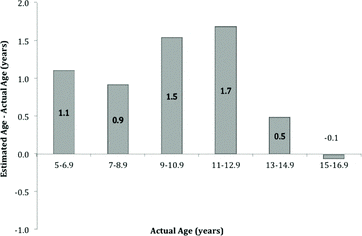
Figure 2. Differences between estimated and actual ages for boys using Demirjian’s centile charts (p<0.01).
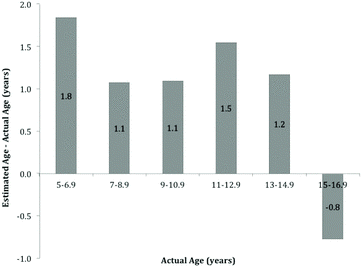
Table 2. Results from single sample t-test comparing the actual ages and ages estimated using Dermirjian's original model for girls.
Table 3. Results from single sample t-test comparing the actual ages and ages estimated using Dermirjian's original model for boys.
Sudbury-specific model
Representing the model for girls, shows the maturity centile curves developed specifically for the Sudbury population of girls, with an R2 value of 0.7377. The curve for the boys, , exhibits a similarly weak degree of correlation, with an R2 value of 0.7117. A trend line was applied to each correlation using cubic polynomial regression, and the equation representing that curve is included on the figure for both boys and girls. The equations are as follows:
The estimated ages were calculated where x represents the total maturity score to be entered and y represents the resulting estimated age. shows the average differences in years between the estimated and actual ages per age group for girls, and shows the same for the boys. These age groups are the same as were used in the previous section; however, with a smaller sample, some age groups were not represented. The same general trend was observed in the previous section, with all but the oldest age groups having overestimated ages; however, in this case the underestimations were the largest discrepancies. Girls from 13–14.9 years were, on average, underestimated by 2.75 years, while boys from 11–12.9 years had an average underestimation of 1.06 years. The rest of the differences for both sexes, of all other age groups were less than or equal to 0.3 years.
Figure 5. Differences between estimated and actual ages for girls using the Sudbury-specific centile charts.

Figure 6. Differences between estimated and actual ages for boys using the Sudbury-specific centile charts.

A positive correlation is noted between the estimated and actual ages for the girls and boys (R2 =0.52 and 0.62, , respectively). Although these are not strong correlations, when tested statistically, the estimated ages were found to be statistically similar (p=0.522 for girls and p=0.378 for boys), for two-tailed distributions. Both of these values are higher than the α-level of 0.05, thus chance cannot be eliminated as the source of the differences calculated between the actual and estimated ages. This indicates the Sudbury-specific model does more accurately represent the sample population. The resulting standard deviations of ±1.2 years for boys, and ±1.4 years for girls yields a 95% confidence interval of 2.6 and 2.7, respectively; a much smaller interval than reported for the original Demirjian model.
Intra- and inter-observer error
The percentage of cases with each maximum number of stages assigned differently, as determined following the method described above, between the same observer at two different times is seen in , with 96% of all cases having one stage difference or less between the two scorings. shows the same for the two different observers' scorings. In this case only 74% of the cases were found to have one difference or less between the two scorings. The intra-observer agreement shows very high agreement, while the inter-observer agreement shows moderate agreement.
Discussion
Validating the Demirjian method
The original Demirjian study was based on children of French descent from Montreal, Québec, Canada. As discussed by others, this population is somewhat special as it was a “melting pot”, especially between two ethnicities; North American Indians and European immigrants Citation[31]. According to the 2006 census data on the ancestry of Sudbury, of the 21,255 respondents, 44% of the population identified themselves as Canadian, 40% as French, 22% as English and just under 10% of the population as North American Indian Citation[32]. The higher proportion of Native and French populations within Sudbury was thought to perhaps mirror the context for the original Demirjian model. However, that was not the case, as the model significantly overestimated the ages of the Sudbury sample. The same results have been observed in a number of other population studies across all age groups and for both sexes Citation[15, 25, 32, 33]. The one difference with this study was that in the highest age group for both boys and girls there was an underestimation of the actual ages. Another difference is that there was consistently a higher accuracy in younger individuals, and lower accuracy in older individuals. However, the greatest differences were seen in the 5–6.9-year-old age group for the boys and the 11–12.9-year-old age group for the girls. For both the boys and girls, the smallest differences were also seen in the oldest age group, which is where the lowest accuracy seemed most likely Citation[15].
It was found in this study that the original Demirjian model yielded significantly different results for the estimation of age in a Sudbury-based sample group. This same conclusion was drawn in a number of previous population studies, for example Willems et al. found that the estimated ages for both Belgian boys and girls were significantly different, and Davis and Hāgg found that their Chinese sample was also not adequately represented by the Demirjian model Citation[8, 25].
Developing the Sudbury-specific model
The Sudbury-specific model was based on Chaillet et al.’s study of Belgian children, which followed Willem et al.’s initial investigation into a new set of Demirjian standards Citation[7, 25]. The centile curves in the original model were not polynomial functions. To address this, the axes were switched in order to determine the equations, and then switched back for the aesthetics of the curve. When the axes were exchanged the curve took a third-degree polynomial shape and the proper equation could be applied. As it turns out, this equation was incorrect. When total maturity scores were entered for x inthe equations produced to test the curve randomly, negative values were almost always the result. The same was true of the equations in Chaillet et al.’s study. When a maturity score was entered into their equations the corresponding calculated age was negative and incorrect. For example, substituting a maturity score of 83.18 for x into the equation for boys, resulted in an estimated age of –17 years Citation[7]. This clearly indicates an issue with the equations similar to the problem in the present research. This was due to a known issue in using Excel that requires the equation for the cubic regression be written in scientific notation. This resolved the calculation issue. Once resolved, were produced with their corresponding equations and R2 values.
The main purpose in creating these models, stems from Demirjian, Goldstein and Tanner adding a caveat at the end of their original publication. They state Citation[23]:
The dental maturity scores for given chronological age may well be greater or less in other populations, according as to whether they are more or less dentally advanced during growth.
At the end of the revised standards provided by Willems et al. the same caveat is still included Citation[25]. While Demirjian, Goldstein and Tanner go on to recommend their system for universal application, many authors have agreed that specific standards for each population are needed for accurate estimations. Of note are the differences seen between Eastern and Northern Turkish Children. Even within the same country some authors deem that specific standards are required to give valid age estimations, placing an emphasis on geographic region instead of country boundaries for generating standards Citation[15, 32]. Although, overall, Olze found Demirjian’s system to be the best dental ageing method, there was one point of contention, where the different estimated ages generated from populations using different standards affects the accuracy of the method to different degrees in different areas Citation[26]. Our study did determine that the original model did not adequately represent the Sudbury population, and that the model developed specifically from Sudbury was able to better estimate the age of children from the area. The results using this method were found to be significantly better and gave a 95% confidence interval of just over two and a half years, compared with the three- and four-year confidence intervals calculated with the Demirjian model for this sample population. While the correlation coefficients were not found to be especially high in this study, it is suggested that with a larger sample group, particularly more individuals younger than 8 years of age, the resulting regression curve could better account for this end of the sample population and yield a better correlation across all age groups.
Intra- and inter-observer error
Regardless of the applicability of the method to the population in question, previous studies found that the Demirjian system was a reliable method, with high levels of reproducibility (). Olze argues that Citation[26]:
Table 4. Summary of the previously completed population studies for Demirjian's method.
Demirjian’s classification system performed best not only for observer agreement but also for correlation due to the fact that there are a sufficient number of stages with definitions without speculative estimations of length.
This study found that while the method was highly reliable with the same observer, the results were not as reproducible between two observers. As seen in , only 74% of all inter-observer cases can be considered “in agreement” (those with a maximum of one stage different or less) and this is significantly less than the 96% of cases in intra-observer agreement. The observed discrepancies seen in the current study may be due to the educational, and experiential differences between the two observers. While both were trained in the same manner, and calibrated to make sure they were assigning stages in a manner that properly followed the guideline set out by Demirjian et al. Citation[23], the primary observer did have more education regarding dental ageing methods, and more experience working with them and viewing panoramic radiographs than the secondary observer. In addition, some other studies used the “Dental Development” CD-ROM training tool developed by Demirjian that may have helped ensure complete calibration of the observers Citation[37, 38]. Overall this study found the Demirjian method to have substantial, but nowhere near perfect, reliability.
Limitations
The sample size of the study was fairly small, with only a total of 237 useable panoramic radiographs being evaluated. Although it has been discussed by Flood that small sample size can be a non-issue Citation[35], it is possible that this could have introduced sample bias in this study. If the individuals who frequent the two dental clinics that the samples were taken from were systematically different from the rest of the Sudbury population, then the sample group used in this study would not properly reflect the true population of the Sudbury area.
As with any population study, one must also consider the inherent variation present in any population that may or may not have affected the results present.
Summary and conclusions
The main goals of this study were to evaluate the use of the Demirjian method and to test a new model developed specifically for the Sudbury area to get the most accurate estimations of age from dentition. It was believed that this would be possible due to the significant lapse in time and geographic distance between the standards originally created for the Demirjian method and the present population. Statistically, the Sudbury-specific model gave more accurate results than Demirjian’s original model, but there are still some discrepancies that are fairly large for use in a forensic scenario. With standard deviations of less than ±2 years however, the Sudbury-specific model is preferred. When testing the reliability of this method, the Sudbury specific model was found to have a high level of reproducibility with the same observer, but demonstrated a lower level of agreement between different observers.
One potential impact of this study is that the resulting model and equations may be locally applied to cases within the Sudbury region. It would be beneficial, however, to test this method on a population-specific sample from forensically relevant scenarios. Sample groups could be drawn from previously completed forensic cases where dental X-rays were required, or by requesting panoramic radiographs in future cases to be used to study the possible effects decomposition may have on applying this dental age assessment method to immature remains. Saunders and Liversidge did test various age estimation methods, although not including Demirjian’s method, on a skeletal collection, with results showing that the atlas-type methods yielded better results Citation[20, 36]. It would also be useful to explore the application of population specific models using deceased individuals in order to compare these results to those using radiographs of living children.
Also of interest is the meta-analysis of eight different countries, combining and comparing dental development information to test differences between vastly different geographic regions, as done by Liversidge et al. Citation[12]. As reported in a few studies so far, no significant differences were seen between the various populations Citation[14, 32]. Some next steps for this research should include testing this International Demirjian Method on the Sudbury-based sample group as has been done with other populations Citation[36].
Acknowledgements
We thank the Department of Forensic Science, Forensic Osteology Laboratory for its support of this research. We are indebted to Dr Paul Kyle and his staff for supplying additional panoramic radiographs.
References
- Cameriere R, Ferrante L, Cingolani M. Age estimation in children by measurement of open apices in teeth. Int J Legal Med. 2006:120(1):49–52.
- Diz P, Limeres J, Salgado AFP, Tómas I, Delgado LF, Vázquez E, Feijoo JF. Correlation between dental maturation and chronological age in patients with cerebral palsy, mental retardation, and Down’s syndrome. Res Dev Disabil. 2011:32(2):808–817.
- Logan WHG, Kronfeld R. Development of the human jaws and surrounding structures from birth to the age of fifteen years. J Am Dent Ass. 1933:20(3):379–427.
- Blenkin MRB. Forensic Dentistry and its Application in Age Estimation from the Teeth using a Modified Demirjian System [Master of Science in Dentistry]. Sydney, Australia: University of Sydney; 2005.
- Cameriere R, Flores-Mir C, Maurico F, Ferrante L. Effects of nutrition on timing of mineralization in teeth in a Peruvian sample by the Camiere and Demirjian methods. Ann Hum Biols. 2007:34(5):547–556.
- Demirjian A, Levesque G-Y. Sexual Difference in Dental Development and Prediction of Emergence. J Dent Res. 1980:59(7):1110–1122.
- Chaillet N, Willems G, Demirjian A. Dental maturity in Belgian children using Demirjian’s method and polynomial functions: new standard curves for forensic and clinical use. J Forensic OdontoStomatology. 2004:22(2):18–27.
- Davis PJ, Hāgg U. The accuracy and precision of the “Demirjian System” when used for age determination in Chinese children. Swed Dent J. 1994:18(3):113–116.
- Lee S-H, Lee J-Y, Park H-K, Kim Y-K. Development of third molars in Korean juveniles and adolescents. Forensic Sci Int. 2009:188(1–3):101–111.
- Baghdadi Z, Pani SC. Accuracy of population-specific Demirjian curves in the estimation of dental age of Saudi children. Int J Paediatric Dent. 2011:22(2):1–7.
- Cruz-Landeira A, Linares-Argote J, Martínez-Rodríguez M, Rodríguez-Calvo MS, Otero XL, Conchiero L. Dental age estimation in Spanish and Venezuelan children. Comparison of Demirjian and Chaillet scores. Int J Legal Med. 2010:124(2):105–112.
- Liversidge HM, Chaillet N, Mörnstad H, Nyström M, Rowlings K, Taylor J, Willems G. Timing of Demirjian’s tooth formation stages. Ann Hum Biol. 2006:33(4):454–470.
- Lee S-S, Lee S, Lee U-Y, Seo JS, Ahn YW, Han S-H. Validity of Demirjian’s and modified Demirjian’s method in age estimation for Korean juveniles and adolescents. Forensic Sci Int. 2011:211(1–3):41–46.
- Liversidge HM. Interpreting group differences using Demirjian’s dental maturity method. Forensic Sci Int. 2010:201:95–101.
- Tunc ES, Koyoturk AE. Dental age assessment using Demirjian’s method on northern Turkish children. Forensic Sci Int. 2008:175(1):23–26.
- Mani SA, Naing L, John J, Samsudin AR. Comparison of two methods of dental age estimation in 7–15 year-old Malays. Int. J Paediatric Dent. 2008:18(5):380–388.
- Chen JW, Guo J, Zhou J, Liu RK, Chen TT, Zou SJ. Assessment of dental maturity of western Chinese children using Demirjian’s method. Forensic Sci Int. 2010:197(1–3):119e1-e4.
- Heuze Y, Cardoso HFV. Testing the Quality of Nonadult Bayesian Dental Age Assessment Methods to Juvenile Skeletal Remains: The Lisbon Collection Children and Secular Trend Effects. Am J Phys Anthropol. 2008:135(3):275–283.
- Moorrees FA, Fanning EA, Hunt EE. Age Variation of Formation Stages for Ten Permanent Teeth. J Dent Res. 1963:42:1490–1502.
- Saunders S, DeVito C, Herring A, Southern R, Hoppa R. Accuracy Tests of Tooth Formation Age Estimation for Human Skeletal Remains. Am J Phys Anthropol. 1993:92(2):173–188.
- Gustafson G, Koch G. Age estimation up to 16 years of age based on dental development. Odont. Revy. 1974:25(3):297–306.
- Anderson DL, Thompson GW, Popovich F. Age Attainment of Mineralization Stages of the Permanent Dentition. J Forensic Sci. 1976:21(1):191–200.
- Demirjian A, Goldstein H, Tanner JM. A new system of dental age assessment. Hum Biol. 1973:45(2):211–227.
- Demirjian A, Goldstein H. New systems for dental maturity based on seven and four teeth. Ann Hum Biol. 1976:3(5):411–421.
- Willems G, Van Olmen A, Spiessens B, Carels C. Dental age estimation in Belgian children: Demirjian’s technique revisited. J Forensic Sci. 2001:46(4):893–895.
- Olze A, Bilang D, Schmidt S, Wernecke K-D, Geserick G, Schmiling A. Validation of common classification systems for assessing the mineralization of third molars. Int J Legal Med. 2005:119(1):22–26.
- Merwin DR, Harris EF. Sibling similarities in the tempo of human tooth mineralization. Arch Oral Biol. 1998:43(3):205–210 .
- Fekonia A. Hypodontia in orthodontically treated children. Eur J Orthodont. 2005:27(5):457–460.
- Microsoft Corporation. Excel:mac. 2008; Version 12.3.2. Licensed to Caitlin Gilbert, Laurentian University. Product ID: 92715-500-2411677-12642.
- AnalystSoft Inc., StatPlus:mac LE – free statistical analysis program for Mac OS. Version 2009. See Available from: www.analystsoft.com
- Chaillet N, Nyström M, Demirjian A. Comparison of Dental Maturity in Children of Different Ethnic Origins: International Maturity Curves for Clinicians. J Forensic Sci. 2005:50(5):1164–1174.
- Statistics Canada. 2012. Sudbury, Ontario (Code 3552) and Ontario (Code 35) (table). Ethnic origins. 2006 Census. Statistics Canada Catalogue no. 98-316-XWE. Ottawa. Released February8, 2006. Available from: http://www12.statcan.ca/census-recensement/2006/dp-pd/hlt/97–562/pages/page.cfm?Lang=E&Geo=CD&Code=3552&Data=Count&Table=2&StartRec=1&Sort=3&Display=All&CSDFilter=5000
- Hägg U, Matsson L. Dental maturity as an indicator of chronological age: the accuracy and precision of three methods. Eur J Orthod. 1985:7(1):25–34.
- Celikoglu M, Cantekin K, Ceylan I. Dental Age Assessment: The Applicability of Demirjian Method in Eastern Turkish Children. J Forensic Sci. 2011:56(1):220–222.
- Flood SJ, Mitchell WJ, Oxnard CE, Turlach BA, McGeachie J. To Evaluate the Utility of Smaller Sample Sizes when Assessing Dental Maturity curves for Forensic Age Estimation. J Forensic Sci. 2011:56(6):1604–1609.
- Liversidge HM. Accuracy of Age Estimation from Developing Teeth of a Population of Known Age (0–5.4 years). Int J Osteoarch. 1994:4(1):37–45.
- Burt NM, Sauer N, Fenton T. Testing the Demirjian and the International Demirjian Aging Methods on a Mixed Ancestry Urban American Subadult Sample from Detroit, MI. J Forensic Sci. 2011:56(5):1296–1301.
- TeMoananui R, Kieser JA, Herbison P, Liversidge HM. Estimating Age in Maori, Pacific Island and European Children from New Zealand. J Forensic Sci. 2008:53(2):401–404.
- Bassed RB, Briggs C, Drummer OH. Age Estimation and the Developing Third Molar Tooth: An Analysis of an Australian Population Using Computed Tomography. J Forensic Sci. 2011:56(5):1185–1191.
- Flood SJ, Mitchell WJ, Oxnard CE, Turlach BA, McGeachie J. A Comparison of Demirjian’s Four Dental Development Methods for Forensic Age Assessment. J Forensic Sci. 2011:56(6):1610–1615.
- Flores AP, Sanhueza MA, Barboza P, Monti CF. Study of Chilean Children’s Dental Maturity. J Forensic Sci. 2010:55(3):735–737.
- Ashith BA. Age Estimation in Indians Using Demirjian’s 8-teeth Method. J Forensic Sci. 2011:56(1):124–127.
- Bagherpour A, Imanimoghaddam M, Bagherpour MR, Einolghozati M. Dental age assessment among Iranian children aged 6–13 years using the Demirjian method. Forensic Sci Int. 2010:197(1–3):121e1-e4.
- Nik-Hussein NN, Kee KM, Gan P. Validation of Demirjian and Willem’s methods for dental age estimation for Malaysian Children aged 5–15 years old. Forensic Sci Int. 2011:204(1–3):208e1-e6.
- Blankenship JA. Third Molar Development in the Estimation of Chronologic Age in American Blacks as Compared with Whites. J Forensic Sci. 2007:52(2):428–433.
- Pathak HV, Dixit P, Shrigiriwar M, Bardale R. Orthopantomographic Evaluation of Canine and First Premolar Using Demirjian’s Stages in Central India: New Approach to Forensic Age Estimation. J Forensic Sci. 2012:51(1):1–5.

